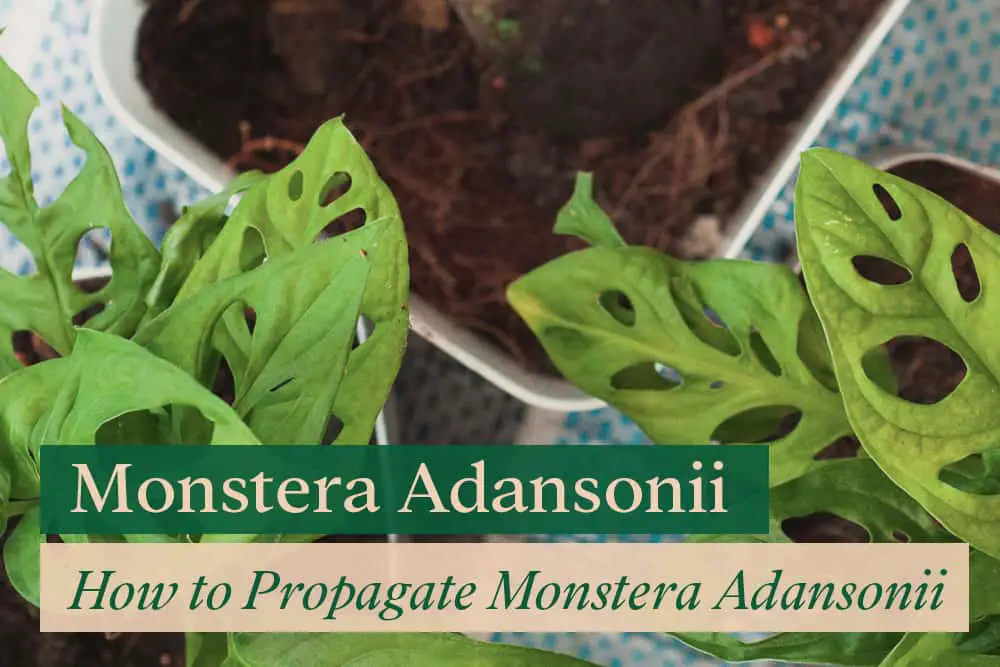
Have you been wanting to propagate your Monstera Adansonii but not sure how to do it?
Monstera Adansonii cuttings should be made an inch below a leaf node using clean, sharp shears. Then, you can either root them in water first or directly into the soil.
In this article, I will walk you through both methods of propagating Monstera Adansonii. I will include tips, considerations, and aftercare advice for success with both propagation techniques.
This article will cover:
- Soil vs water propagation: which is better?
- Consideration before propagating your Monstera Adansonii
- Steps to propagate in water
- Steps to propagate in the soil
- Aftercare for propagated cuttings
Let’s get started!
Disclaimer: As an Amazon Associate I earn from qualifying purchases.
Propagating in Water or Soil: Which is better?
As you may know, propagating Monstera Adansonii can be done in water or soil. But, which technique is better?
Well, I have propagated Monstera Adansonii in both techniques and had successful results using both methods. However, I find that the plant cuttings propagated in soil grow much faster.
This does not mean that propagating the monkey mask plant in water doesn’t have its own set of benefits. Let’s explore the choices:
Advantage of Propagating Adansonii in Water
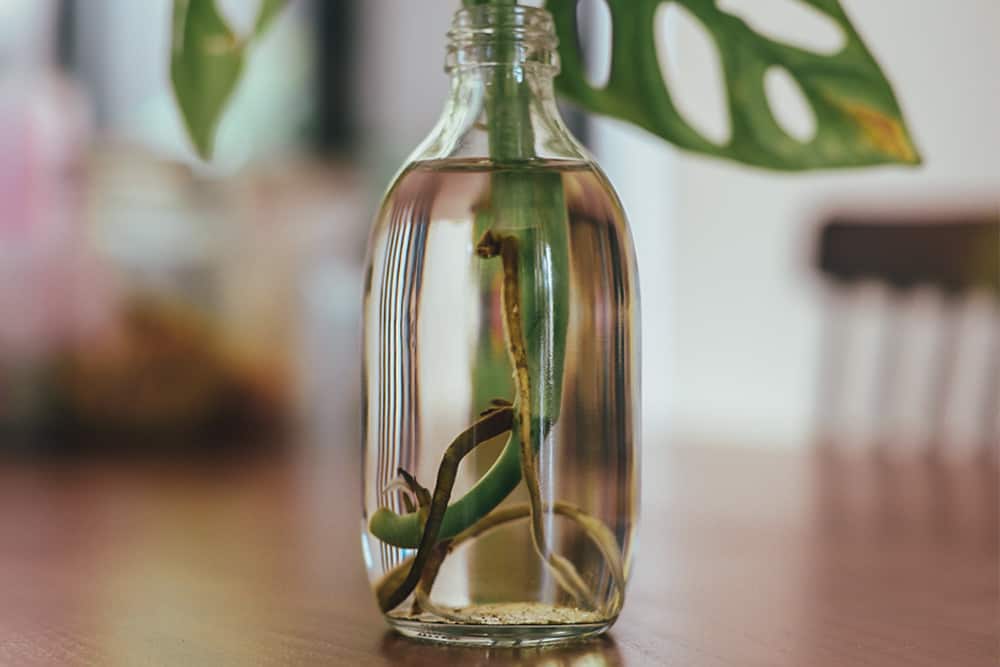
- You can propagate Monstera Adansonii in water with little effort. I usually propagate my freshly pruned cuttings in water if I do not have potting soil and pots prepared to put them in.
- I find it easier to monitor the rooting progress and watch for signs of rot, plus I can teach my kids about plant growth.
- Propagation in water is less messy. You don’t need to worry about spilling soil on the floor.
- A water-propagated Monstera Adansonii is a stunning centerpiece for your living spaces.
- Even if you leave the cuttings in the water permanently, Monstera Adansonii will continue to develop new leaves.
Consideration of Propagating Adansonii in Water
- Monstera Adansonii will not receive proper nutrients commonly found in potting soil needed for optimal growth.
- Monstera Adansonii’s water roots are not well-adapted to absorb nutrients in the soil, which means that it will need to develop new roots once transplanted.
- You should change the water in the container once a week, or it will start to look unpleasant.
Advantage of Propagating Adansonii in Soil
- Propagating directly into the soil is a one-time process that does not disturb the roots as much as it would if you start with water.
- Transplanting into a proper potting mix will provide the plants with the nutrients and micronutrients needed for healthy growth.
- I experimented with propagating Monstera Adansonii, taking a piece from the same mother plant and placing it in water and soil. The Swiss Cheese plant grows more new leaves when planted in soil.
Consideration of Propagating Adansonii in Soil
- Propagating a Monstera Adansonii plant directly into soil requires thorough planning and preparation.
Things to Note & Prepare Before Propagating a Monstera Adansonii
Although propagating Monstera Adansonii seems straightforward, there are a few things to note and prepare before you even start cutting your swiss cheese vine.
Best time to Propagate
You should propagate Monstera Adansonii only during its growing season between early Spring to Summer. This is to ensure that the cutting has sufficiently developed roots to survive the winter.
Also, early morning is the best time to start taking a cutting and propagating as the Swiss cheese plant is fully turgid.
If you want to give your cutting to a friend, make sure that it is cool and moist. Put the cutting in a wet paper towel and store it in a clear plastic bag.
Get your tools ready.
Here are the tools you need to propagate Monstera Adansonii:
When propagating your Monstera Adansonii, you’ll want to use clean pruning shears or a very sharp knife. Cutting with a blunt blade will result in tears on both the mother plant and cuttings- which means the plant will need more time for healing.
If you have sensitive skins, you should wear hand gloves during propagation, as saps in Monstera Adansonii can cause mild skin allergies and irritation.
Pick your pot or water vessel.
Whether you propagate Monstera Adansonii in water or soil, you must prepare the pot or vessel beforehand.
Placing the cutting in a temporary pot or bottle until you get your proper pot can disturb the root system development.
For soil propagation: Use any pot you like, including a hanging basket, as long as it has a drainage hole at the bottom of the pot.
For water propagation: Use a wide mouth container with at least 4 inches of diameter to easily remove the cutting once they root.
Prepare your potting mix.
As you probably know, Monstera Adansonii prefers aerated and well-draining soil.
You can purchase one online, or you can always mix them yourself! I made my own potting soil using a mixture of orchid bark, coco fiber, perlite, activated charcoal, and worm casting.
Purchase a moss pole
During my first Monstera Adansonii propagation, I forgot to buy a moss pole. I only put it in after a few months.
However, I found out that putting a moss pole in place after roots have developed can actually damage them.
Please don’t make the mistake that I’ve made. If you want your Swiss cheese plant to climb, install a moss pole straight away as you propagate them into the soil.
Plan your cuttings
I bet you know that Monstera Adansonii will not root without at least one node on the cutting. This is why it is crucial to plan your cuttings beforehand.
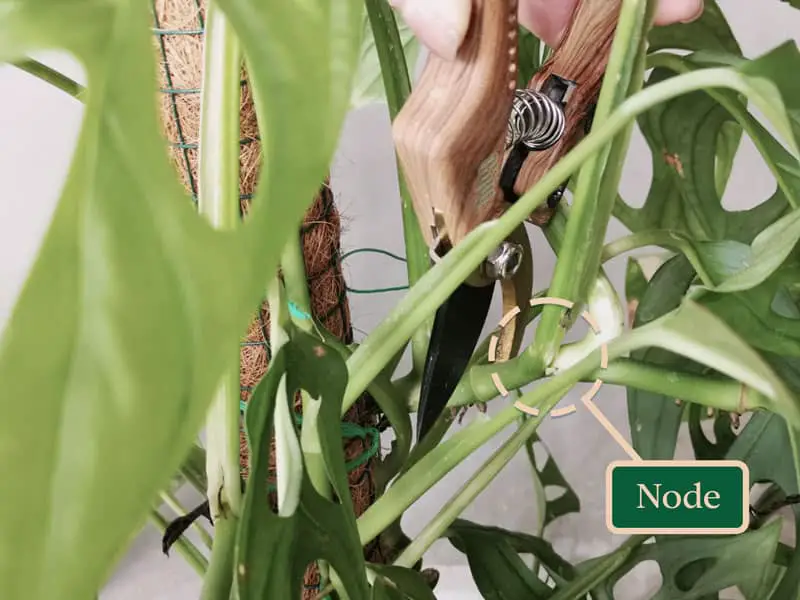
You can identify the nodes in Monstera Adansonii as the light green splits where new stems and leaves have developed. You can also often see little roots poking out from the node, and this is the plant’s aerial roots.
In general, you should cut a few inches below the nodes to allow root development. By cutting a 45-degree angle on the internodes, you can also help the roots develop faster as there is a larger surface area for water intake.
Step by Step Propagating in Water
Let’s start with the easier method.
Here is how you can propagate your Monstera Adansonii in water:
Step 1: Use a pair of pruning shears to take a stem cutting of 3 to 5 monstera leaves. Make sure you cut at least an inch below the node.
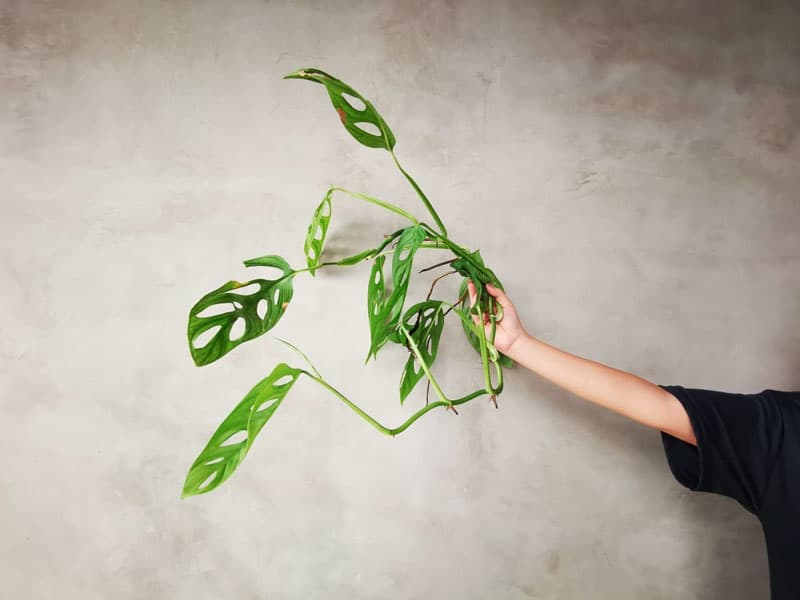
Step 2: When propagating Monstera Adansonii in a tall vessel, be sure to remove bottom leaves so that the leaves are not submerged. Ensure that at least one node is underwater.
Step 3: Give the cuttings proper care by changing the water regularly every week and provide it with bright, indirect sunlight. I’ll discuss more about care for your water-rooted cuttings later in this article.
Step 4: You will notice small roots sprouting after a few weeks. However, you will need to wait until the roots are at least 2 inches before you can transplant them into the soil. This process usually takes about a month but can vary depending on many factors.
Also, note that you can always leave your Monstera Adansonii in the water forever.
Step by Step Propagating in Soil
Now, here is how you can propagate your Monstera Adansonii in soil:
Step 1: Fill half of your pots or hanging baskets with an aerated and well-draining soil mixture.
Step 2: Insert a moss pole or trellis into the soil in the pot. You obviously do not need vertical support on hanging baskets as they will look more attractive as trailing vines.
Step 3: Take a cutting of at least one leaf and a node with clean, sharp shears from the original plant.
Step 4: Place the cutting on the soil and add more soil until the node is covered.
Step 5: If you have more leaves, loosely secure the stem onto a moss pole with garden ties or velcro to encourage it to both climb and produce new growth.
Step 6: There is no way to know if your Monstera Adansonii has developed new roots, but just believe that with proper care, your cutting will grow and flourish.
Caring for Your New Propagated Cuttings
Congrats for successfully propagating your Monstera Adansonii! The hard part is done; now, you just need to maintain it with proper care.
Your propagated cuttings routine care will be very similar to other Monstera plant care:
Watering frequency
When propagating Monstera Adansonii in soil, it is important to water the plant moderately with distilled water once a week or when the top 2 inches of soil are dry.
Make sure the water drains out of the bottom of the pot to avoid overwatering and root rot.
On the other hand, water-propagated Swiss cheese plants need weekly care by removing algae or dirt from the vase and replenishing it with fresh distilled water.
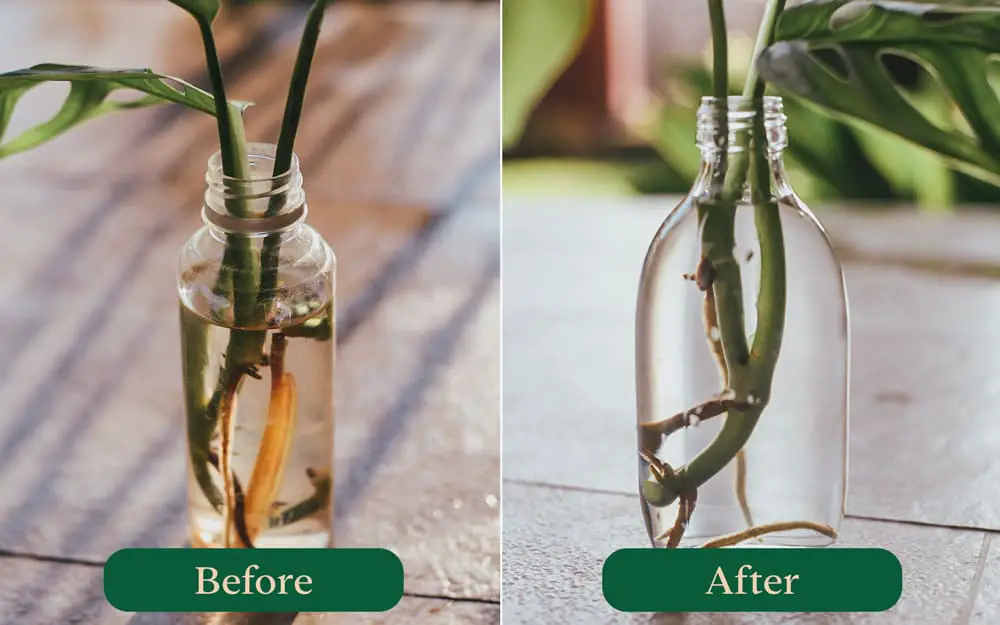
Light
Monstera Adansonii cutting thrives from 10 – 12 hours of bright, indirect light. Avoid placing your cuttings in direct sun as it may cause sunburn to the leaves.

The best scenario is to place your new plant 5 to 10 feet away from a south-facing window with sheer curtains to filter the sunlight.
Although Monstera Adansonii is tolerant of lower light, you should consider purchasing grow lights for your propagated cuttings in very low light conditions.
Temperature & Humidity
Monstera Adansonii thrives in temperatures well above 60°F (16°C), but they do best in more normal household temperatures of 75°F to 80°F (24°C to 27°C) with a relative humidity level above 50%.
During the winter months, the temperature can drop, and the air becomes dry. It is best to you turn on the heater and plant humidifier to counter excessive transpiration from the leaves.
Fertilizer
Regardless of your propagation techniques, you will need to provide the plants with fertilizers for optimizing root growth.
I fertilize both my Monstera Adansonii cuttings in the soil and water every month using a very diluted Maxsea fertilizer (just 1/8 teaspoon per gallon water).
Do not over-fertilize the plants, or else you risk damaging them. Doing so will both impede their ability to absorb nutrients and water.
Soil Mixture
As I mentioned earlier, you will need to plant your cutting in an aerated and well-draining potting mix.
If you have constantly wet soil, it needs to be re-potted into a better mix of soil.
Check out my DIY soil mixture guide for Monstera to learn more about making your own potting mix.
Frequently asked questions:
How long will it take for my propagated Monstera Adansonii to grow roots?
After propagating the Monstera Adansonii in water, you will start noticing the plant begins to grow new roots within just a few weeks.
However, it would be best to wait until the roots are at least 2 inches long before planting them in the soil. This process will take at least four weeks.
Can it take my Monstera Adansonii longer than four weeks to grow roots?
Under unsuitable growing conditions, it can take longer for your water-propagated plant to root.
Make sure to change the water weekly and expose the plant to bright indirect light. Also, make sure to maintain the room temperature at 75°F to 80°F (24°C to 27°C) and humidity level at least 50%.
Can I get variegated Monstera Adansonii or Monstera Obliqua with propagation?
Unfortunately, Monstera Adansonii Variegata is an extremely rare plant. Your chance of randomly producing variegation through propagation is about 1 in 100.000.
Monstera Obliqua is a different plant species altogether. So, it is not possible to get it by propagation.
